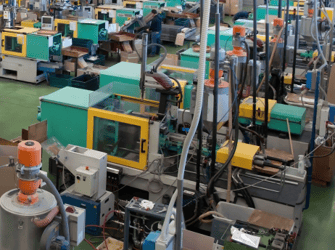
Many times when processes go awry the true cause is not identified. Too often significant changes are made without a just reason behind them, other than the assumption that “I know how to fix that.” Every technician has a silver bullet and they always think it’s a better fix than the one provided by the previous shift. Before making any major changes to your process, you should always consider the 5 M’s.
1.) MAN
By far, the easiest culprit to identify is #1. If the process is running in semi-automatic and the cycle time is dependent on the machine operator, this is one of the major factors. Inconsistent cycle time can cause issues with material temperature and residence time variations. This contributes to mold temperature inconsistency, not to mention lost productivity and increased scrap rate.
2.) MACHINE
Look at the actual readings on the machine and not the set points. Are the machine functions (hydraulic / temperature / time) functioning properly? Are the set points met in a normal response time? Once these have been checked, move on to the next M.
3.) METHOD
Is the machine set to the process set up sheet? The slightest variations from the set up sheet can have huge impacts on the process over even a short period of time. A process adjustment log is a great tool to have with the set up sheet / book. Also, process deviations should not be allowed unless explicitly approved by the Process Manager and the book should be updated immediately after the process variation has been approved.
4.) MOLD
The mold should not be a factor if it is maintained, has had full PM’s performed at its scheduled intervals, and is within its life span of cycles produced. That being said, a tool that is not clean and venting properly will most definitely create problems. Burn marks, splay, bubbles, heavy weld lines, just to name a few. Manifold tools equipped with valve gates (or non-valve gates) that have multiple heaters can be tricky. Identifying the problem area may require data to be collected over a period of time. Scatter / Concentration charts are very helpful in identifying where the problem originates.
5.) MATERIAL
If you're still reading, you may need to ask yourself the following questions: Has the material changed recently? Has a new lot been introduced? Has regrind been introduced? Has the melt Index of the material changed? Normally this is not the cause unless many changes have been made. If this is in question, a good place to check would be with incoming receiving. They should have the information needed to evaluate. Has the material feed been interrupted and the machine ran empty? If using a hygroscopic material, has the material had sufficient time to dry at the correct temperature? Hygroscopic materials encapsulate moisture within the pellet. Non-hygroscopic materials collect surface moisture and also need to be dried prior to production. Normally these materials require drying at low temperatures for short amounts of time.
By examining the 5 M's, you should be well on your way to identifying the cause of your process defects. Contact us if you'd like some more recommendations on how to improve your process and reduce your defects.
Ready to reduce your production downtime to protect your profits? Learn more about how purging compounds and process efficiency work in tandem.







Comments